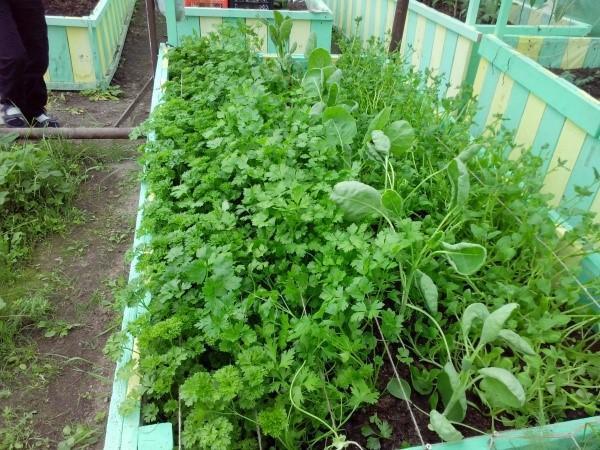Planting parsley correctly
 By its nature, parsley is an unpretentious plant. In whatever way and method it is planted, the seeds germinate almost always and almost all. However, this is still not enough, because the main thing in a difficult gardening business is not only to plant a crop, but also to get an excellent harvest from it.
By its nature, parsley is an unpretentious plant. In whatever way and method it is planted, the seeds germinate almost always and almost all. However, this is still not enough, because the main thing in a difficult gardening business is not only to plant a crop, but also to get an excellent harvest from it.
Unfortunately, quite often, friendly beautiful seedlings do not please with lush and juicy greenery. Either the leaves are too small, or in general most of the landings go into the arrows. To avoid such phenomena, it is necessary to properly plant the spice and give it a little attention. You also need to consider the variety.
Varieties of parsley
Everyone can choose a fragrant herb to their liking, starting from the appearance and shape of the leaves and ending with the final purpose of use (tops or roots).
Among the popular varieties, the following are worth highlighting:
- Root parsley Spicy... It is grown for the sake of obtaining fragrant roots. Biennial. This variety is unique: even if you cannot get large roots, you can leave them in the ground for the winter, and in the spring the very first greens will grow on such a bed. In addition, the plants later form flower stalks and sow themselves. So, without unnecessary hassle, by the next season already good root parsley.
- Leaf parsley Italian giant... An annual plant, it has large leaves on long petioles, resembling parsnips. Quickly builds up leaf mass.
- Leaf parsley Gloria. It is able to hibernate in the open ground and itself renews. Early ripe variety.
- Parsley is universal Bogatyr. As the name implies, the bush grows not only leaves, but also small roots.
- Curly parsley Petra. It differs in the original shape of the leaves - they are not simple, even, but corrugated, while retaining their appearance after cutting. The variety is often used to decorate dishes.
Curly parsley looks very beautiful on flower beds as a border. Compact, low, lush and green bushes will favorably set off a multi-colored flower bed until the very frost.
Where does parsley grow best?
Unlike dill, parsley is very shade-tolerant and can be easily planted under trees. Moreover, on sandy soils, there can be no other option, the bushes will simply burn out in the sun, because such soil dries up quickly. But if you sow seeds in the shade, the plants will feel comfortable there - and the sun does not get hot, and moisture lingers longer.
To make sandy soil more suitable for cultivation, you need to add compost to the site, and water the plantings themselves more often.
How to sow seeds outdoors?
For parsley seeds to sprout better, the area for the beds should be well loosened - dig up the soil and level the surface with a rake. But if you have a Fokin flat-cutter, a shovel is no longer needed - it is enough for them to walk along the future beds.
If desired, you can make grooves or simply scatter the seeds over the allotted area. Then water abundantly. For the first time (7-10 days), the beds can be covered with spandbond or foil, so that shoots appear faster.
To accelerate the germination of seeds, before sowing, they must be rinsed in well warm water to remove the film from essential oils.
Does parsley need feeding?
If the soil is fertile and nutritious, the greens will grow juicy and without additional fertilization.But it is advisable to fertilize the beds on scanty sandy soils by watering the bushes at the root several times per season with an infusion based on manure or grass.